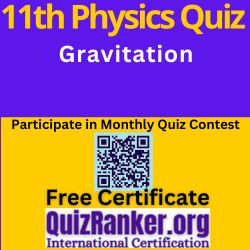Test your understanding through Physics Gravitation MCQ Quiz with these multiple-choice questions (MCQs). Challenge yourself and improve your grasp of gravitational concepts for CBSE and NEED Exam.
Attempt Physics Gravitation MCQ Quiz
You can also participate in Physics Quiz Contest every month as well as yearly physics quiz competition on official international QuizRanker website.
Brief about this Gravitation
Early in our lives, we notice that objects are naturally drawn towards the Earth—whether it’s something falling when thrown up, the effort required to walk uphill versus downhill, or raindrops descending from clouds. This gravitational force, first comprehensively studied by Italian physicist Galileo (1564-1642), revealed that all objects experience a constant acceleration towards Earth regardless of their mass. Galileo’s groundbreaking experiments with inclined planes contributed to understanding this acceleration, laying the foundation for more precise measurements later on.
Meanwhile, the observation of celestial bodies such as stars and planets has fascinated humanity since ancient times. Early astronomers noted the fixed positions of stars and the intriguing motions of planets against this backdrop. Ptolemy’s geocentric model, proposed around 2000 years ago, asserted that all celestial bodies, including the Sun and planets, orbited the Earth in circular paths. This theory, elaborated upon by Indian astronomers later on, was complex, requiring intricate schemes to explain planetary movements.
However, the heliocentric model, where the Sun sits at the center of the solar system with planets orbiting it, was advanced much earlier by Aryabhatta in the 5th century AD. This model gained prominence with the work of Copernicus in the 16th century, though it faced opposition from the church, with Galileo famously enduring persecution for his support of heliocentrism.
Around the same period, Danish nobleman Tycho Brahe meticulously recorded planetary observations, which were later analyzed by Johannes Kepler. Kepler’s laws of planetary motion, derived from Brahe’s data, provided a significant leap in understanding celestial mechanics. These laws, known to Isaac Newton, played a pivotal role in his formulation of the universal law of gravitation—a cornerstone in modern physics, unifying celestial and terrestrial mechanics.
Chapter 1 Units and Measurements MCQ and NCERT Question Answer
1.1 Introduction
1.2 The international system of units
1.3 Significant figures
1.4 Dimensions of physical quantities
1.5 Dimensional formulae and dimensional equations
1.6 Dimensional analysis and its applications
Chapter 2 Motion in A Straight Line MCQ and NCERT Question Answer
2.1 Introduction
2.2 Instantaneous velocity and speed
2.3 Acceleration
2.4 Kinematic equations for uniformly accelerated motion
Chapter 3 Motion In A Plane MCQ and NCERT Question Answer
3.1 Introduction
3.2 Scalars and vectors
3.3 Multiplication of vectors by real numbers
3.4 Addition and subtraction of vectors – graphical method
3.5 Resolution of vectors
3.6 Vector addition – analytical method
3.7 Motion in a plane
3.8 Motion in a plane with constant acceleration
3.9 Projectile motion
3.10 Uniform circular motion
Chapter 4 Laws of Motion MCQ and NCERT Question Answer
4.1 Introduction
4.2 Aristotle’s fallacy
4.3 The law of inertia
4.4 Newton’s first law of motion
4.5 Newton’s second law of motion
4.6 Newton’s third law of motion
4.7 Conservation of momentum
4.8 Equilibrium of a particle
4.9 Common forces in mechanics
4.10 Circular motion
4.11 Solving problems in mechanics
Chapter 5 Work, Energy and Power MCQ and NCERT Question Answer
5.1 Introduction
5.2 Notions of work and kinetic energy : The work-energy theorem
5.3 Work
5.4 Kinetic energy
5.5 Work done by a variable force
5.6 The work-energy theorem for a variable force
5.7 The concept of potential energy
5.8 The conservation of mechanical energy
5.9 The potential energy of a spring
5.10 Power
5.11 Collisions
Chapter 6 System Of Particles And Rotational Motion MCQ and NCERT Question Answer
6.1 Introduction
6.2 Centre of mass
6.3 Motion of centre of mass
6.4 Linear momentum of a system of particles
6.5 Vector product of two vectors
6.6 Angular velocity and its relation with linear velocity
6.7 Torque and angular momentum
6.8 Equilibrium of a rigid body
6.9 Moment of inertia
6.10 Kinematics of rotational motion about a fixed axis
6.11 Dynamics of rotational motion about a fixed axis
6.12 Angular momentum in case of rotations about a fixed axis
Chapter 7 Gravitation MCQ and NCERT Question Answer
7.1 Introduction
7.2 Kepler’s laws
7.3 Universal law of gravitation
7.4 The gravitational constant
7.5 Acceleration due to gravity of the earth
7.6 Acceleration due to gravity below and above the surface of earth
7.7 Gravitational potential energy
7.8 Escape speed
7.9 Earth satellites
7.10 Energy of an orbiting satellite
Study Source:
Total Views: 31


